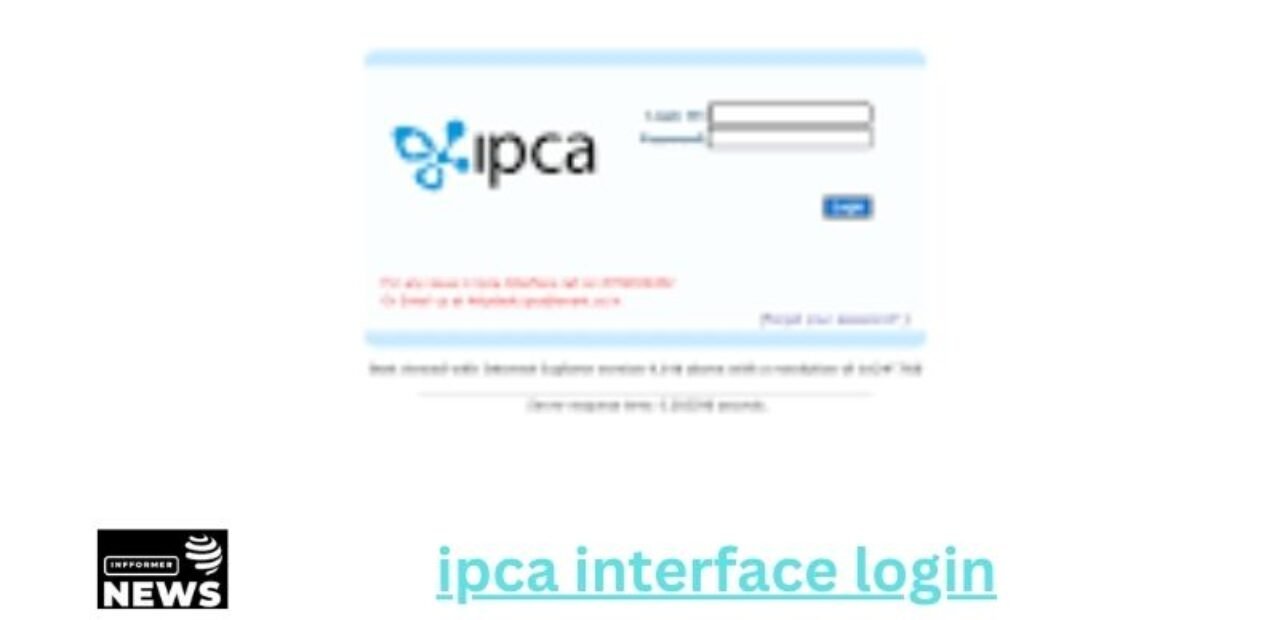Ipca Interface Login – Full Info 2024
The IPCA (Interstate Public Communications Alliance) interface login is a critical entry point for users seeking access to a range of services and functionalities associated with the IPCA platform. As businesses and institutions increasingly leverage digital platforms for communication and data management, understanding the login process and its implications becomes essential for users aiming to maximize their experience on the platform. This article provides a comprehensive overview of the IPCA interface login, detailing its significance, the login process, troubleshooting tips, and best practices for security.
Understanding the IPCA Interface
The IPCA interface is designed to facilitate seamless communication between various stakeholders within the organization, including employees, management, and external partners. This platform enables users to access crucial information, collaborate on projects, and manage administrative tasks efficiently. The interface is user-friendly, ensuring that even individuals with minimal technical expertise can navigate its features effectively.
The significance of the IPCA interface extends beyond mere access to information; it enhances productivity by streamlining communication processes. Users can share documents, track progress on tasks, and engage in discussions in real-time. This integrated approach not only saves time but also fosters a collaborative work environment, which is essential in today’s fast-paced business landscape.
The IPCA Interface Login Process
Logging into the IPCA interface is a straightforward process designed to ensure that only authorized users can access the platform. Here’s a step-by-step guide on how to log in:
- Access the Login Page: Begin by navigating to the official IPCA website. The login link is typically located on the homepage, often labeled as “Login” or “Access Portal.” Clicking this link will redirect you to the login page.
- Enter Credentials: On the login page, you will be prompted to enter your username and password. It is crucial to input these details accurately to avoid login errors. Ensure that your caps lock is off, as passwords are case-sensitive.
- Two-Factor Authentication (If Applicable): For enhanced security, some organizations may require two-factor authentication. This process involves entering a code sent to your registered mobile number or email after inputting your password. Follow the instructions provided to complete this step.
- Login: After entering your credentials and any necessary authentication codes, click the “Login” button. If your information is correct, you will be redirected to your user dashboard.
- Forgot Password: If you cannot remember your password, there is typically a “Forgot Password?” link on the login page. Clicking this will initiate a password reset process, allowing you to regain access to your account.
Troubleshooting Common Login Issues
Despite the straightforward nature of the login process, users may encounter several common issues. Here are some troubleshooting tips to resolve these problems effectively:
- Incorrect Credentials: If you receive an error message indicating incorrect login details, double-check your username and password for accuracy. Remember to check for case sensitivity and any accidental spaces before or after your credentials.
- Account Lockout: After several unsuccessful login attempts, your account may become temporarily locked for security reasons. In this case, wait for a brief period before trying again or contact your IT support team for assistance in unlocking your account.
- Browser Compatibility: Ensure that you are using a compatible web browser. Some users may experience issues with outdated browsers or specific settings. Clearing your browser’s cache and cookies can also resolve unexpected login issues.
- Internet Connection: A weak or unstable internet connection can lead to login failures. Check your internet connection and try refreshing the page before attempting to log in again.
- Technical Support: If you continue to experience difficulties logging in, it is advisable to contact your organization’s technical support team. They can provide specific guidance and resolve any underlying technical issues.
Best Practices for Security
Maintaining the security of your IPCA interface login credentials is paramount to safeguarding your information and the integrity of the platform. Here are several best practices to enhance your login security:
- Use Strong Passwords: Create complex passwords that include a mix of uppercase letters, lowercase letters, numbers, and special characters. Avoid using easily guessable information, such as birthdays or common words.
- Change Passwords Regularly: It is advisable to change your password periodically, such as every three to six months. This practice reduces the risk of unauthorized access to your account.
- Enable Two-Factor Authentication: If your organization offers two-factor authentication, enable this feature. It adds an extra layer of security by requiring a second form of verification, making it more difficult for unauthorized users to gain access.
- Log Out After Use: Always log out of your account when finished, especially if you are accessing the platform from a shared or public computer. This practice prevents others from accessing your account without permission.
- Monitor Account Activity: Regularly review your account activity for any unauthorized access or unusual behavior. If you notice anything suspicious, report it to your IT support team immediately.
Conclusion
The IPCA interface login serves as a gateway to a wealth of resources and tools designed to enhance communication and collaboration within organizations. Understanding the login process, potential issues, and security measures is essential for users to navigate the platform effectively and safely. By adhering to best practices for security and being aware of common login issues, users can ensure a smooth and productive experience on the IPCA platform. As technology continues to evolve, staying informed about updates and changes to the IPCA interface will empower users to make the most of this valuable resource.
Read also: check





























































